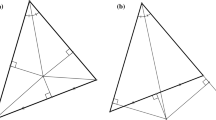Abstract
In this paper we provide an analysis of the logical relations within the conceptual or lexical field of angles in 2D geometry. The basic tripartition into acute/right/obtuse angles is extended in two steps: first zero and straight angles are added, and secondly reflex and full angles are added, in both cases extending the logical space of angles. Within the framework of logical geometry, the resulting partitions of these logical spaces yield bitstring semantics of increasing complexity. These bitstring analyses allow a straightforward account of the Aristotelian relations between angular concepts. In addition, also relational concepts such as complementary and supplementary angles receive a natural bitstring analysis.




Similar content being viewed by others
Notes
In this paper, we systematically use degrees to measure angles.
See [20] for the introduction of this diagrammatic representation format for scalar structures.
See [3, Section 3] for an analogous kite-based analysis of the mathematical terminology of compatibility and strong/weak contrariety.
Aristotelian diagrams like these—as well as the JSB hexagon discussed above—are called \(\alpha \)-structures by Moretti [13]. See [4] for some further theoretical results on (the Boolean properties of) \(\alpha \)-structures, and [11] for another example of a decagonal \(\alpha \)-structure, which once again derives from the works of Schopenhauer.
See [6, Section 4.3] for a more detailed analysis of the strong/weak Boolean subfamilies of the Aristotelian family of JSB hexagons.
The case \(i = 3\) will be discussed in more detail later.
References
Balbiani, P., Goranko, V., Kellerman, R., Vakarelov, D.: Logical theories for fragments of elementary geometry. In: Aiello, M., Pratt-Hartmann, I., van Benthem, J. (eds.) Handbook of Spatial Logics, pp. 343–428. Springer, New York (2007)
Blanché, R.: Structures Intellectuelles. J. Vrin, Paris (1969)
Demey, L.: Metalogic, metalanguage and logical geometry. Logique et Anal. (N.S.) 248, 453–478 (2019)
Demey, L.: From Euler diagrams in Schopenhauer to Aristotelian diagrams in logical geometry. In: Lemanski, J. (ed.) Language, Logic, and Mathematics in Schopenhauer, pp. 181–205. Springer, Cham (2020)
Demey, L., Smessaert, H.: Duality in logic and language. In: Fieser, J., Dowden, B. (eds.) Internet Encyclopedia of Philosophy, pp. 1–37. University of Tennessee, Martin (2016)
Demey, L., Smessaert, H.: Combinatorial bitstring semantics for arbitrary logical fragments. J. Philos. Log. 47, 325–363 (2018)
Givant, S., Halmos, P.: Introduction to Boolean Algebras. Springer, New York (2009)
Horn, L.: A Natural History of Negation, 2nd edn. CSLI Publications, Stanford (2001)
Jacoby, P.: A triangle of opposites for types of propositions in Aristotelian logic. New Scholasticism 24, 32–56 (1950)
Jaspers, D.: Logic and colour in cognition, logic and philosophy. In: Silva, M. (ed.) How Colours Matter to Philosophy, pp. 249–271. Springer, Cham (2017)
Lemanski, J., Demey, L.: Schopenhauer’s partition diagrams and logical geometry. In: Basu, A., et al. (eds.) Diagrammatic Representation and Inference, pp. 149–165. Springer, Cham (2021)
Moktefi, A.: Schopenhauer’s Eulerian diagrams. In: Lemanski, J. (ed.) Language, Logic, and Mathematics in Schopenhauer, pp. 111–127. Springer, Cham (2020)
Moretti, A.: The Geometry of Logical Opposition. PhD thesis, Université de Neuchâtel, Neuchâtel (2009)
Partee, B. (1987) Noun phrase interpretation and type-shifting principles. In: Groenendijk, J., de Jongh, D., Stokhof (eds.) Studies in Discourse Representation Theory and the Theory of Generalized Quantifiers, pp. 115–143. Dordrecht, Foris
Pellissier, R.: Setting n-opposition. Log. Univers. 2(2), 235–263 (2008)
Renz, J., Nebel, B.: Qualitative spatial reasoning using constraint calculi. In: Aiello, M., Pratt-Hartmann, I., van Benthem, J. (eds.) Handbook of Spatial Logics, pp. 161–215. Springer, New York (2007)
Schopenhauer, A.: The World as Will and Representation (translated and edited by J. Norman, A. Welchman and C. Janaway). Cambridge University Press, Cambridge (2010)
Sesmat, A.: Logique II. Hermann, Paris (1951)
Seuren, P.A.M., Jaspers, D.: Logico-cognitive structure in the lexicon. Language 90(3), 607–643 (2014)
Smessaert, H., Demey, L.: The unreasonable effectiveness of bitstrings in logical geometry. In: Béziau, J.Y., Basti, G. (eds.) The Square of Opposition: A Cornerstone of Thought, pp. 197–214. Springer, Berlin (2017)
Weisstein, E.: Concise Encyclopedia of Mathematics. CRC Press, Boca Raton (1999)
Author information
Authors and Affiliations
Corresponding author
Additional information
Publisher's Note
Springer Nature remains neutral with regard to jurisdictional claims in published maps and institutional affiliations.
This research is supported via the ID-N research project Bitstring Semantics for Human and Artificial Reasoning (BITSHARE). The second author holds a research professorship (BOFZAP) at KU Leuven. Thanks to Jens Lemanski, Andrew Schumann and two anonymous reviewers for their feedback on an earlier version of this paper.
Rights and permissions
Springer Nature or its licensor holds exclusive rights to this article under a publishing agreement with the author(s) or other rightsholder(s); author self-archiving of the accepted manuscript version of this article is solely governed by the terms of such publishing agreement and applicable law.
About this article
Cite this article
Smessaert, H., Demey, L. On the Logical Geometry of Geometric Angles. Log. Univers. 16, 581–601 (2022). https://doi.org/10.1007/s11787-022-00315-7
Received:
Accepted:
Published:
Issue Date:
DOI: https://doi.org/10.1007/s11787-022-00315-7
Keywords
- Aristotelian relations
- Bitstring semantics
- Logical geometry
- Acute/right/obtuse angle
- Zero/straight angle
- Reflex/full angle
- Complementary/supplementary angles




